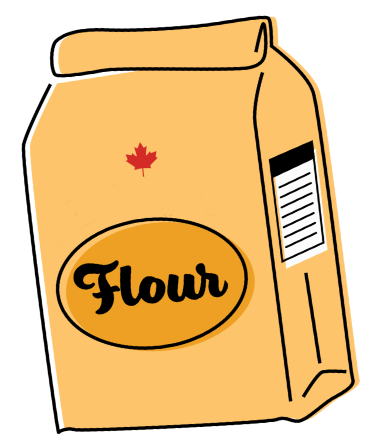

Choosing the right flour
Everything you need to know about wheat flour

Meet Matthew James Duffy
Matthew James Duffy is a classically trained chef, baker, and professor with over 20 years of experience in top kitchens and bakeries around the world. Today, he teaches Baking and Pastry Arts at Centennial College in Toronto and is the author of Bread, Etc.—a baking book designed to build confidence, technique, and intention in the kitchen.
If you’ve ever stood in the baking aisle wondering whether to choose whole wheat, all-purpose, or bread flour, you’re not alone. Wheat flour is one of the most commonly used ingredients in kitchens around the world—and there are almost as many types of flour as the foods you can make with it.
Whether you’re baking bread, thickening a sauce, rolling out noodles or making pasta, each type of wheat flour is milled with a purpose, contributing distinct characteristics, nutrients, and performance to your cooking and baking.
FLOUR FACTS
Whether you’re baking bread, cookies, or your first sourdough, choosing the right flour can make all the difference.

TYPES OF FLOUR
Understanding the differences can help you choose the right flour for better results in your baking and cooking. Here’s a quick guide to the most common types and how to use them.
Whole Wheat Flour
Whole wheat flour adds fibre, additional nutrients and texture to your baking.
Whole Grain Whole Wheat Flour
Whole grain whole wheat flour is made using 100% of the wheat kernel: the bran, germ, and endosperm.
Bread Flour
Made from hard wheat and milled to contain only the endosperm, this flour has a higher protein content (typically around 12-14%) that supports the formation of a strong gluten matrix.
Cake or Pastry Flour
This enriched refined flour is made from the endosperm of soft wheat and has a lower protein content (typically around 6-10%), which creates tender textures and a fine crumb.
Atta Flour
Atta flour is a traditional whole wheat, whole grain flour used widely for making flatbreads like chapati, roti, and paratha. It’s made by stone-grinding the entire wheat kernel (bran, germ, and endosperm) into a fine flour.
Semolina
Semolina is a coarse, granular product made by milling durum wheat, the hardest type of wheat grown in Canada.
00 Flour
Milled to an ultra-fine consistency, this specialty flour is prized for its smooth texture and performance in baking.
Self-Rising Flour
This convenient flour combines refined wheat flour with added baking powder and salt, making it a ready-to-use option for recipes that require leavening.

STORAGE TIPS
Proper storage helps maintain flour’s freshness, flavour, and baking performance:
- Store in an airtight container in a cool, dry place.
- Refrigerate or freeze whole wheat and whole grain flours to extend shelf life.
- Keep away from heat, humidity, and strong odours.
- Check best-before dates and use older flour first.
Flour Quick reference
Protein % |
Fibre per 100 G |
Enriched & fortified |
Best for |
|
|---|---|---|---|---|
| All-purpose Flour | 10-14% | 3 g | Yes | Everyday baking, cookies, muffins, pancakes and pizza dough |
| Whole Wheat Flour | 14% | 8.9 g | No | Adding fibre to muffins, sandwich loaves and everyday baked goods |
| Whole Grain Whole Wheat Flour | 13% | 13 g | No | Sourdough bread, high fibre muffins, and artisanal crackers |
| Bread Flour | 12-14% | 3 g | Yes | Hearth and sandwich loaves, crusty rolls, artisan bread, and pizza dough |
| Cake or Pastry Flour | 6-10% | 3 g | Yes | Cakes, cupcakes, pie crusts, and pastries |
| Atta Flour | 13% | 6 g | Yes | Flatbreads like chapati, roti, and paratha |
| Semolina | 13% | 4g | Not required, if added will be on the ingredient label | Pasta and couscous |
| Durum Flour | 12-13% | 4 g | Yes | Pasta, flatbreads, and Mediterranean-style breads or blending |
| 00 Flour | 8-12% | 3 g | Yes | Thin-crust pizza, homemade pasta, and delicate Italian pastries |
| Self-Rising Flour | 10% | 3 g | Yes | Quick breads, biscuits, pancakes, and muffins |
PARTS OF A WHEAT KERNEL
Every wheat kernel is made up of three parts: germ, bran and endosperm. When wheat kernels are milled into flour, millers can produce flours containing the entire kernel, selected parts, or just a single component.
Bran: The outer layer of the kernel. It’s rich in fibre, iron, B vitamins, and minerals. Bran adds texture and a slightly nutty flavour to whole grain products.
Endosperm: The largest portion of the kernel, composed mostly of carbohydrates and protein. It supplies energy to the growing plant and is the part of the kernel primarily used to make all-purpose flour.
Germ: The nutrient-dense core of the kernel, where a new plant sprouts. It contains healthy fats, B vitamins, vitamin E, and minerals like zinc and magnesium.

In 2024 Canada grew enough wheat to make 59.5 billion loaves of bread
From sandwich loaves to noodles and pasta, Canada’s wheat is feeding Canadians—and helping nourish the world.

Canada is one of the world’s top wheat producers and exporters, known for supplying high-quality wheat to over 80 countries.
This reputation is built on wheat varieties developed for consistent protein strength, gluten performance, and milling quality—traits that make Canadian wheat ideal for flours and semolina used in bread, pasta, noodles, and pastries.
Canadian millers are the largest domestic buyers of Canadian wheat, transforming it into enriched, specialty flours and semolina that meet the needs of professionals and home cooks.
Behind every crop are the Canadian farmers who grow these premium grains, contributing over 32 million tonnes of wheat every year*—a vital part of food systems in Canada and around the world.
*The five-year average wheat production (2020-2024) is 32.4 million tonnes.


